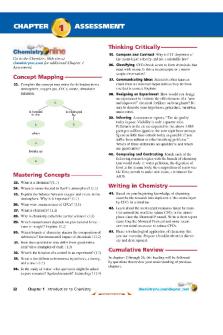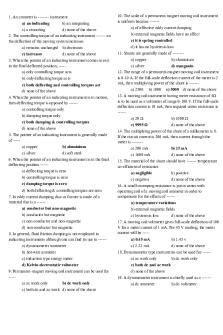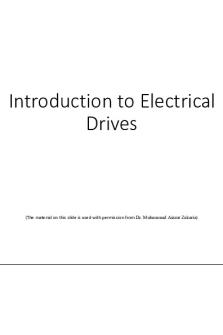Electrical Phoresis Part 1 PDF

| Title | Electrical Phoresis Part 1 |
|---|---|
| Author | Joshua Rupert |
| Course | Clinical Biochemistry II |
| Institution | University of Ontario Institute of Technology |
| Pages | 4 |
| File Size | 79.7 KB |
| File Type | |
| Total Downloads | 129 |
| Total Views | 532 |
Summary
Protein Review- Proteins are linear polymers of alpha-amino acids with ionizable amino and carboxyl groups. These groups are what allow them to be either positive or negative depending on the pH of the medium they’re in. - In acidic environments, amino groups will take on hydrogen to become positive...
Description
MLSC-3111, Clinical Biochemistry II Protein Review -
-
-
Proteins are linear polymers of alpha-amino acids with ionizable amino and carboxyl groups. These groups are what allow them to be either positive or negative depending on the pH of the medium they’re in. In acidic environments, amino groups will take on hydrogen to become positively charged, while carboxyl groups will give up hydrogen and become negatively charged. Ampholytes, molecules that can be negatively or positively charged. Isoelectric Point (PI), the pH at which the protein has a net zero charge. Water is polar, so the protein must be charged to stay in solution and react with the water to dissolve. At its pI, it is the most unstable and neutrally charged, allowing it to precipitate out of solution. The pI of most plasma proteins is between pH 4-7, so at a pH of 7.4 the proteins are negatively charged and can dissolve in solution. This is why a change in blood pH can be fatal since the proteins will reach their pI and precipitate out of the blood and block flow everywhere.
Electrophoresis -
-
-
-
-
The method of separating charged particles by their rates of migration across a support medium in an electric field. Serum protein electrophoresis (SPE) on agarose gel is a type of horizontal gel electrophoresis. Proteins can be identified with this method by controlling the systems parameters and migration distance. When consistent, the patterns of certain particles can be used to identify proteins accurately. Zone Electrophoresis, produces zones of macromolecules that are homogenous (only one protein per group) or heterogenous (several similar proteins in one zone) for less specific identification. Resolution, degree of separation obtained or the ability to identify two species as separate bands. The quality of resolution depends on the conditions preferred by the substances and their phenomena. An electrical field is applied to the system through two oppositely charged electrodes in solution. The voltage is the “push” that force the proteins towards their oppositely charged electrode (anode is positive and cathode is negative). The movement of charged particles in solution is affected by its interaction with water molecules. When proteins are attracted to water, their migration is affected because it won’t migrate as far as we want it to. In the beginning, samples are placed at the exact predetermined location on the support medium. Next, the support medium is placed into a chamber and contacts the buffer. Constant voltage is applied to generate the electrical field. The molecules will then respond by separating by migrating to the electrode of their opposite charge.
MLSC-3111, Clinical Biochemistry II -
Small and highly charged molecules will migrate quickly while larger weakly charged molecules will migrate slowly. Electrophoretic Mobility, rate of migration per unit field strength. Migration is the result of driving forces and resisting forces on the molecules.
Factors Affecting the Rate of Migration -
-
-
-
-
-
-
Net Charge, the greater the net charge of the molecule, the greater the mobility it shows. The molecule is more attracted to the oppositely charged electrode and therefor moves faster. o Effective Mobility, mobility is directly proportional to the magnitude of the net charge. Buffer, the buffer serves to provide ions to create current, imparts the pH of the solution to provide optimal net charge of molecules and maintains the pH throughout the process. The most common buffer is barbital or tris-boric-EDTA. Serum proteins are negatively charged at a pH of 8.6. At a low pH, they will be positively charged. Buffers must be refrigerated (improves band resolution and lessens evaporation during electrophoresis) and changed in each electrophoresis run. Usually buffer strips are used instead for easy storage and replacement compared to storing large volumes of liquid buffer. Size and Shape, size and weight are inversely proportional to rate of migration. Asymmetrical molecules migrate slower than symmetrical proteins in solution. Charge to Mass Ratio, the main determining factor for migration. The net charge in combination with the size and shape of the molecule determines its rate of migration. Support Medium, the support medium must be inert and should not bind to molecules being separated. The viscosity and pore size of the support medium also influences migration since increased viscosity slows migration. Molecules cannot move through thicker media as quickly as we want. Pore Size, increased pore size leads to increased migration because it is easier for molecules to move through larger “holes” in the medium. Gel pore size can be selected according to the size of the molecules. Smaller molecules are less affected by smaller pore sizes than larger molecules. However, if the pore size is too large, some molecules will go so fast that they will end up all the way in the buffer strip on the other side. Time, increasing the duration of the run time increases the migration distance of the molecules. The farther they migrate the larger the distance in bands, so increasing the time increases the resolution. However, excessive run time may cause diffusion of molecules into the gel to decrease resolution. Diffusion, random molecular movement that leads to the broadening of bands and a loss of resolution. Diffusion is directly proportional to temperature and time and inversely proportional to the charge-to-mass ratio and medium viscosity. Thickness of gel slows diffusion and a higher affinity to the charged electrode decreases diffusion into the gel.
MLSC-3111, Clinical Biochemistry II -
-
-
-
-
Temperature, heat increases thermal agitation of proteins, which increases rate of migration. However, heat can denature proteins and give us “ugly bands” and melt the gel. Heat also increases evaporation of buffer causing buffer to have a higher ionic strength which decreases rate of migration. Field Strength, the strength of the electrical field can be increased by increasing the voltage. The higher the voltage the faster the migration. When increasing voltage, heat is produced (heat is produced when current flows through a medium that has resistance). Ionic Buffer Strength, the buffer serves to maintain conductance (the degree to which a specified material conducts electricity). Conductivity is increased by adding more salts (ions) to the buffer which in effect increases buffer ionic strength. Ionic strength is determined by the charge on the ion in solution and the concentration of ions in mmol/L. Increasing buffer ionic strength (making the buffer more concentrated/charged) increases # of buffer ions/charge in the buffer ionic cloud and the attraction of the sample ions to the buffer. The slower movement of solutes from increased ionic strength creates sharper bands (increased ionic strength improves resolution). Increased ionic strength of the buffer affects the size of the ionic cloud which decreases the rate of migration but improves the sharpness of the separated solutes.
Types of Support Medium -
-
-
-
Agarose Gel (AGE), used in our clinical labs and is the most common medium. Made from agar that is extracted from seaweed. The medium is composed of a 3D network of cross-linked polymers that trap buffer in the pores between the polymers. Agarose gels have the largest sized pores of all support media. Pore size is affected by the concentration of polymers in the gel; more polymers mean smaller pores. Since agarose gel has larger pores, the pores in gel allow for separation of proteins based on charge to mass ratio, not size. Agarose gel is naturally clear when it dries. Agarose gels with smaller pores are used for DNA fragment separation based on molecular size as all DNA has the same charge-to-mass ratio. Stains for protein are amido black Coomassie Blue and DNA is stained using a fluorescent stain. Polyacrylamide Gel, also known as PAGE, is a gel formed by polymerizing and crosslinking. Considered to be stronger than agarose gel while being thermostable and transparent. The pore size can be changed by changing concentration of acrylamides used. o Molecular Sieving, PAGE separates molecules based on charge-to-mass ratio and size. Allows more fractions of smaller size to be separated and detected than AGE. o Sodium dodecyl sulfate (SDS) PAGE, uses detergent that denatures proteins (lose protein folding and become smaller in size). More separations are achieved by layering polyacrylamide gels with differing pore sizes.
Types of Driving Forces
MLSC-3111, Clinical Biochemistry II
-
-
-
Constant Voltage, increased ionic strength leads to increased current. Increased current will lead to increased heat which increases the rate of migration. However, heat also causes ugly wavy bands, melted gel and denatured proteins. This is what happens when you change the ionic strength while keeping voltage constant. Constant Current, increased ionic strength leads to a decrease in voltage. A decrease in voltage causes a reduction in electrical field which causes a slowed migration but little to no extra heat production. Requires more time for separation due to slow migration and may lead to increased diffusion (poor resolution). Clinical lab systems often use constant voltage to speed up electrophoresis and add cooling systems to solve these issues.
Summary -
-
Migration is increased by: o Increased net charge o Increased pore size of medium o Increased current o Increased pH o Increased temperature (if protein not denatured) Migration is decreased by: o Increased molecular size o Increased ionic strength o Increased viscosity of supporting medium o Increased temperature (if high enough to denature protein)...
Similar Free PDFs

Electrical Phoresis Part 1
- 4 Pages

Electrical Material Part 1
- 4 Pages

Part 1
- 2 Pages

Electrical-cable
- 395 Pages

Module 1 - Assessment Part 1
- 2 Pages

Exam #1 Part 1 Review
- 6 Pages

Makalah part 1
- 14 Pages
Popular Institutions
- Tinajero National High School - Annex
- Politeknik Caltex Riau
- Yokohama City University
- SGT University
- University of Al-Qadisiyah
- Divine Word College of Vigan
- Techniek College Rotterdam
- Universidade de Santiago
- Universiti Teknologi MARA Cawangan Johor Kampus Pasir Gudang
- Poltekkes Kemenkes Yogyakarta
- Baguio City National High School
- Colegio san marcos
- preparatoria uno
- Centro de Bachillerato Tecnológico Industrial y de Servicios No. 107
- Dalian Maritime University
- Quang Trung Secondary School
- Colegio Tecnológico en Informática
- Corporación Regional de Educación Superior
- Grupo CEDVA
- Dar Al Uloom University
- Centro de Estudios Preuniversitarios de la Universidad Nacional de Ingeniería
- 上智大学
- Aakash International School, Nuna Majara
- San Felipe Neri Catholic School
- Kang Chiao International School - New Taipei City
- Misamis Occidental National High School
- Institución Educativa Escuela Normal Juan Ladrilleros
- Kolehiyo ng Pantukan
- Batanes State College
- Instituto Continental
- Sekolah Menengah Kejuruan Kesehatan Kaltara (Tarakan)
- Colegio de La Inmaculada Concepcion - Cebu








